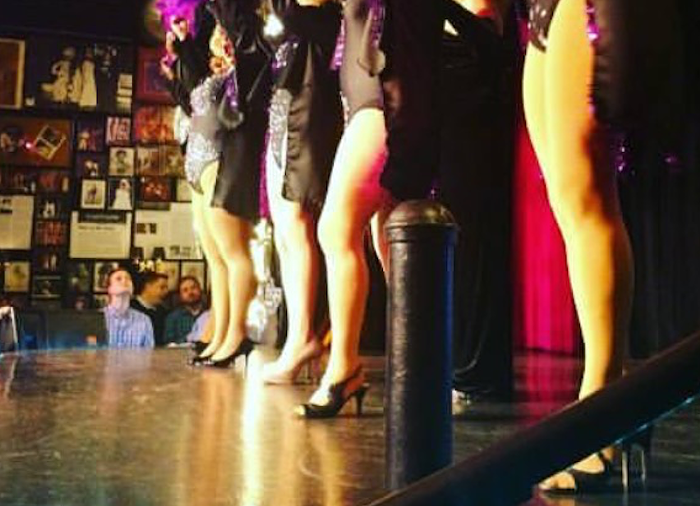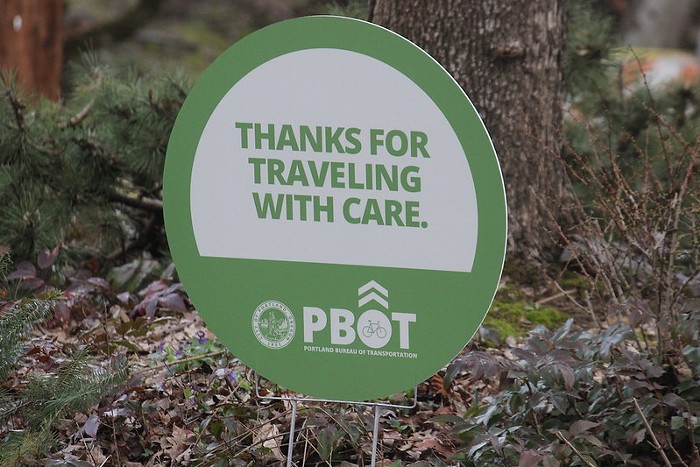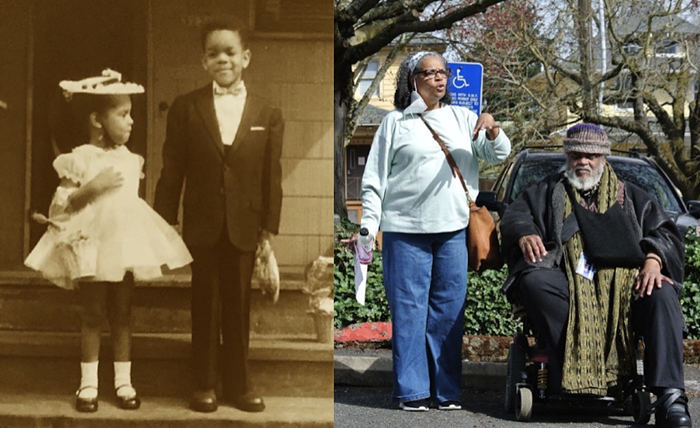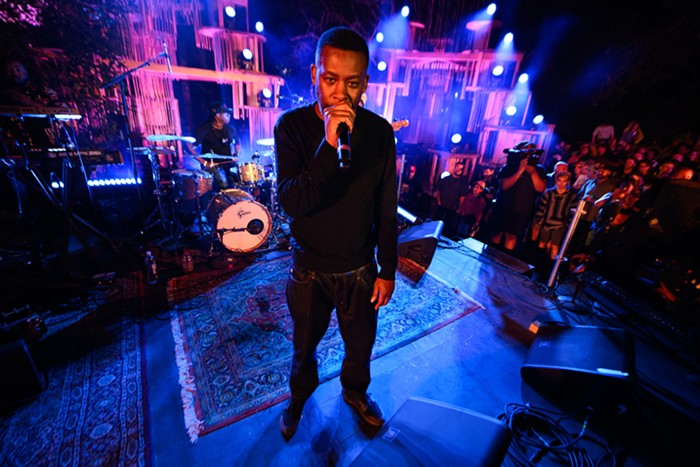I FINISH MY CIGARETTE on the cyborg's doorstep.
Moments before, I was exchanging texts with Amber Case about my progress to this Southeast Portland apartment, the #14 bus hiccupping through its stops. "If you have an iPhone, download Geoloqi and I'll be able to watch you approach," wrote Case.
By day, Case is a user experience designer for Vertigo Software, where she builds interfaces for smartphone apps, servicing the likes of NBC and other world-strong outfits. By night, Case is a "cyborg anthropologist," studying "how humans and non-human objects interact with each other, and how that changes culture"—putting those observations to good use with apps like Geoloqi.
It's a field of study that was first recognized in 1993 by the American Anthropological Association—and now the 24-year-old Case works under its umbrella. Her cyborg anthropologist musings recently hit the stage of TED Talks in a lecture titled, "We Are All Cyborgs Now." (TED is a video series documenting presentations given by innovators from various fields—featuring speakers with "ideas worth spreading.")
I fieldstrip my smoke and rap a short knock on the door. Aaron Parecki, a local programmer who collaborates with Case, answers and invites me in. Case follows behind, offering a warm, professional handshake—as well-mannered cyborgs do. I'm offered a seat at a dining room table that overlooks a panorama of computer monitors (the Geoloqi command center—tracking the geolocational data of a worldwide network of users). Case sits across from me and warms up for our interview with a few parlor tricks—using her iPhone to turn the lights off and on again; triggering an artificial voice that says, "Hey, Matt."
"You can make your house talk?" I ask, laughing.
"Yes," says the house, Case chuckling behind her phone. While these are fun tricks, they aren't what makes a cyborg under Case's accepted definition.
Cyborganthropology.com, Case's website dedicated to the subject, identifies three categories of human-machine combo: "cybernetic organism"; "hybrid of machine and organism"; and "creature of both fiction and lived social reality."
Case believes it's the increasingly mobile internet and its ability to act as an extension of the brain—to store and share unique information with increasing automation and independence—that's turning more and more people cyborg. As Case says, she's not talking about Terminator, she's talking about the Facebook wall and the Twitter stream; how these technologies give us the ability to create an external version of our personalities with which others can interact in our physical absence.
She borrows the term "second self," originally coined by sociologist Sherry Turkle, to describe this unique digital existence.
"When people first went online, they had avatars and fake names and silly pictures and would play around with... multiple identities and it wasn't a big deal," explains Case. "It was fun, it was play. Now, people's identities are tied. You sign up to Facebook with your real name."
Not only does the modern internet user create a second self that's more closely related to the person behind the machine, but their relationships with their computing devices are becoming more intimate. An integral aspect of Case's cyborg studies is to track these changes.
"The idea of cyborg anthropology is looking at what's happening now, and what's becoming normal," says Case. "This," holding up her iPhone, "10 years ago, was not normal."
"But since people just kind of meld into it and it just becomes a part of life, people don't stop and say..." Case does a robot voice, "'I am using a device in my pocket, but I have to charge it every night and when it cries I have to pick it up and I have to soothe it back to sleep and I have to make sure that it's well protected and I have to buy it new accessories.' It's like this little non-human ally in your pocket. You have to treat it correctly. So it's very human."
Though things weren't always this way. Case says that the first computer-based cyborg was an engineer named Steve Mann who designed the original wearable computer back in the 1980s. It was a clunky, 80-pound thing, and he built and coded the entire system himself (which even included a makeshift version of WiFi). And it was a time when bridging the gap between person and computing environment was seen very differently.
"In the beginning, people were like, 'Virtual reality has to be three dimensions,'" says Case, "and it's funny because when you think about it... you don't need three dimensions—your brain can fill in the rest."
While this explains why the virtual reality of social networks works so well, it also explains why our digital interactions can feel as real as physical ones. This can be great in positive situations, but horrible in negative ones, when "your brain really feels hurt because the symbolic equivalent is getting attacked."
She hands me a beer and we settle in for a two-hour conversation during which I start to grasp just how commonplace Case's cyborg really is.
Here, with computer monitors scrolling through constant data and the house chattering away, Case's ability to take the theoretical framework of cyborg anthropology and put it against real-world functionality is evident. Geoloqi is the perfect example of this ability.
What is Geoloqi? It's a smartphone app for real-time location sharing—currently available for iPhone, with an Android version to be released in the coming weeks. Think Foursquare—minus all the "mayor of" and "checking in" stuff—for times when you don't want your entire social network to see where you are. Just as Case described the adolescent period of online avatars—when everyone was experimenting with identities—we're seeing something very similar with location-sharing tools. Opening up your location to the world makes you vulnerable, but when you're wearing the avatar of a fictional mayor, it dampens the perceived risk. It becomes part of a game. Problem is, some people look past the avatars and want location-sharing functionality without all the fiction. Location sharing on their own terms.
Another big Geoloqi feature is the "geonote" function. Say you've found a particularly life-changing curry with a hard-to-remember name—you could leave a geonote for yourself, so when you walk by the restaurant a message pops up, reminding you, "Amazing curry dish, #C9. Do it!" It also gives users the option to subscribe to various info layers (such as earthquake notifications), and the next version will support more complex features, like the ability to automatically send an email to your boss if you're more than five minutes away from work come punch-in time.
While this may sound simple to some, Geoloqi's been a long time coming. For years, Case envisioned a system of text-message alerts that would pop up on phones based on the user's location. She says that at 2008's WhereCampPDX "geohacking" conference, she "gave this impassioned session called Geolocal Auto-Subscribing RSS Feeds."
Standing in front of an audience, she shared her vision. "Here's Portland, here are the quadrants," drawing a diagram on the board, "and when your phone gets in one of these quadrants you should get a text, like, 'You're in Southeast Portland,' or 'You're in Northeast Portland,' and you should be subscribed to the data based on where you are so you get very relevant data... But nobody is doing this and nobody cares and everybody around here doesn't want to work on this with me."
Parecki chimes in. "I was actually in Eugene at that time... [and] I had set up basically the exact same system where there were circles around all the different parts of Eugene and Portland. And as I went around it would keep track of where I was and do interesting things like turn on and off the lights and things."
Their similarities in interest don't stop there. Case says that both her and Parecki practiced very similar second-self grooming.
"We're really digitally close to each other. For instance, we both had the same bot. He had a thing called PK Bot. I had one called Case Bot. And they were both programmed completely differently, and they both did the same thing: every single thing we did online, like if we favorited a photo... or something, it would come up and go to a Case Bot or a PK Bot Twitter stream."
"Then two years later we ended up meeting at Beer and Blog," adds Parecki.
After comparing solutions to past problems and collaborating on smaller projects, Parecki sent Case a modified phone so she too could play with the location-tracking software he designed. Case describes the profound moment when she realized they shared this common interest.
Case says, "I started getting these text messages... '[Amber's handle] Case Organic is in Southeast Portland,' and, 'Case Organic is in Northeast Portland,' and I realized that [Parecki] had done the exact same thing I was talking about at that [WhereCampPDX] session... It was this great moment."
With the help of volunteers, in March of 2010 Geoloqi became a working project—and this past January it was completed and released in Apple's App Store. It's a feature-rich program with the ease of use needed to attract a wide user-base. Moreover, from a cyborg anthropologist standpoint, it has the potential to affect how people interact with mobile technology in a few interesting ways.
Part of what makes a cybernetic relationship work is a technology's ability to transparently help its user—no "ill-fitting prosthetics" need survive. So when a geonote automatically pops up with a grocery list as you walk past the store—without button pressing or screen swiping—Geoloqi is doing for memory what the car did for running, and the telegraph did for speaking. It's removing the human work from a human task.
And it's not just about overcoming a world of slow-me-down buttons, or maturing out of Foursquare fiction, but giving users the tools to create a private side to the second self. Geonotes and other Geoloqi sharing features provide an interface that treats public and private use equally. It applies low-effort, high-function cybernetics to our inner thoughts and private places. It gives a user access to a new type of second self—a private, third self, if you will—that shows up when you need it, and slides back behind the screen when you don't, entering social media's glass arena only when told. It's a big step forward.
Poet and Silver Jews frontman David Berman once wrote, "In the morning you rise from your bed and the self-portraits come streaming in." To me, it means that we are the world we live in, and vice versa; that the pile of clothes on the chair next to the bed somehow describes us, as does a tangle of headphone wire, and the toothbrush sitting in the cup by the sink.
Lying in bed a few weeks after my first meeting with Amber Case, this line took a new meaning. I woke in the morning and the first thing I did was refresh my Gmail tab. I scanned the several hundred tweets that rolled in over the course of the night. I checked for any comments that may or may not have arrived under a story that went to print the previous evening. I didn't think about food, or the cup of coffee awaiting me at the café down the street. I gravitated toward the databases holding the units of my digitized existence.
Pulling the sheets off, I scampered to the bathroom, thinking of my daily online grooming rituals in terms of Case's cyborg. In immediately jumping online each morning, I was in defense mode, readied in the event that I might need to guard my second self from potential defamation. Throughout the day, a balance between my physical and digital existence became more and more apparent.
Waiting for a friend at a coffee shop, I opened my New York Times app and read something about Egypt; half of me doing this to catch up with the world I can't see, and the other half, avoiding the one directly in front of me. Case would call this "social punctuation," which, after my friend arrives, extends into our conversation. I find myself checking for emails at regular intervals throughout coffee hour—to keep a finger on who's trying to get a hold of me, but also filling momentary gaps in conversation. Becoming aware of the social splintering and my divided attention, I slipped my phone in my pocket.
But, like hallucinatory mice under my iPhone's floorboards, a few minutes pass and a phone-shaped vibration sings on my thigh. Pulling my phone out again, no new alerts have arrived. While I've always referred to this phenomenon as phantom phone syndrome, I believe it's indicative of what Case calls "panic architecture," in which frequent alerts and updates of various kinds produce frantic users, obsessively clicking between tabs and consuming little bits of information.
After my friend left, I sat for hours, shuffling through browser tabs—over-editing tweets, deleting them; punctuating the minutes with a refresh of the inbox; the mice endlessly pawing under the screen.
That night at a dinner party, after food and drinks, everyone took turns picking YouTube videos to watch. I pulled up a music video for a song by AU, impulsively deciding to post the video to Tumblr as I hadn't updated my feed in a few days. "Dude, are you blogging right now?" a friend taunted. Yes. Yes, I was. But moreover, I had slid momentarily into my second life, zippering it into my daily consumption without much thought. I shrugged it off and settled back into the video carousel.
But walking home, all the preening of my digital image began to feel incredibly narcissistic. Even though Case says that these practices are generally healthy—a productive practice in maintaining identity—I'm not sure if my particular relationship with technology helps or hurts. Whether internet addiction or more advanced integration with my second self, the David Berman line scrolled behind my active thoughts, "In the morning you rise from your bed and the self-portraits come streaming in."
If these digital interfaces, day in and day out, are self-portraits—the things that describe me—then my secondary digital life has become my central metaphor. After all, when the cup of coffee or morning piss come after a refresh of the Gmail tab, it's fairly obvious which self-portrait best describes me.
With my second life taking an increasingly primary role each passing day, feeling as real as anything else, I too have become a cyborg. Part man, part machine. And I'm okay with it, knowing that people like Case are working to stitch together my two worlds.













